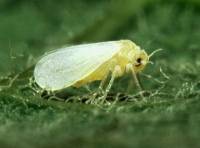Table of Contents
Group 5
<html><font size=6 face=“Arial”>Third wheeling as an invasion strategy</font></html>
Wiki site of the practical exercise of the IX Southern-Summer School on Mathematical Biology.
Here you will find the exercise assignment and the group's products.
If you are a group member login to edit this page, create new pages from it, and upload files.
Introduction

Infestations of the whitefly Bemisia tabaci (left image, from Wikipedia) destroy plantations in the South of USA, Australia, China, among other countries. Several mechanisms have been isolated and tested in experimental settings to reveal how they contribute to this plague's success.
Twelve different biotypes of whitefly have already been distinguished through phylogenetic analysis. One of these biotypes, referred to as 'B biotype', is native from Mediterranean Asia and has been reported rapidly invading worldwide populations of whitefly of other biotypes. For instance, B biotype entered in both China and Australia in the 90s, where the native biotypes are ZHJ1 and AN, respectively.
Liu et al. detected significant changes in sex ratio in both the indigenous and alien populations in both regions. In China, when populations of either B or ZHJ1 occurred alone, B usually had female ratios of 60~70%, which were higher than the 50~60% female ratios in ZHJ1. Very similar results also happened to AN biotype. This difference was even higher when the two different biotypes coexisted during the infestations. Then, the same researchers decided to reproduce this behavior in controlled environments, and observed similar data as in nature, as well as B biotype invasion of indigenous biotypes.
Interestingly, mating experiments between B and ZHJ1 and between B and AN indicated that neither could interbreed, although they could interfere in the frequency of copulation of the other biotype. For instance, in the presence of B biotype indigenous biotype couples could decrease their copulations. Oddly enough, B-couple increases their frequency copulation in the presence of the indigenous biotype. Measurements of frequency of copulation and some other nice information are reported in the Supporting Online Material of Liu et al.
This manipulation happens, literally, as a third wheel - the different biotype is able to court the female, but not to copulate with her. Moreover, copulation by indigenous individuals is partly blocked by B males that readily attempt to court with females of either biotype — a behavior not reciprocated by the indigenous males.
Assignment
Propose and analyze a mathematical model for whitefly populations to investigate the strategy of changing copulation frequency in whiteflies biotypes.
Suggested questions
- Which conditions of frequency of copulation ensures biotype B's capacity to invade and displace indigenous populations? Under what circumstances do you observe B invasion in your model?
- Which conditions verify the sex ratio shifts, given this mating behavior and the fact that whiteflies are haplodiploid?
Further well-grounded questions from the group are welcome.
References
Shu-Sheng Liu, P. J. De Barro, Jing Xu, Jun-Bo Luan, Lian-Sheng Zang, Yong-Ming Ruan, Fang-Hao Wan. Asymmetric Mating Interactions Drive Widespread Invasion and Displacement in a Whitefly Science (2007), Vol. 318, Issue 5857, pp. 1769-1772. https://science.sciencemag.org/content/318/5857/1769.
